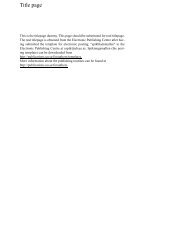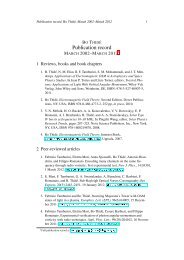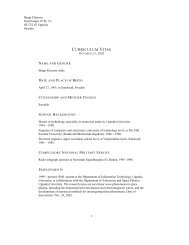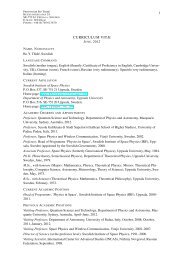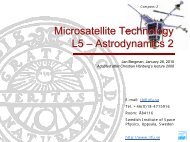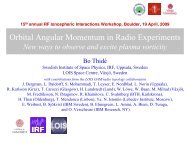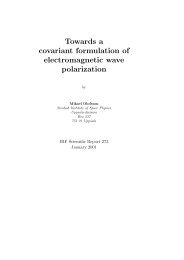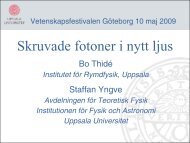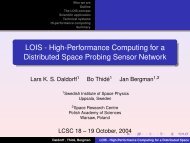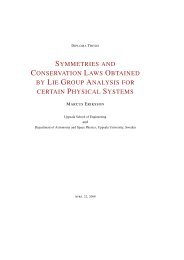Atmosphere-Ionosphere Mission - Swedish Institute of Space ...
Atmosphere-Ionosphere Mission - Swedish Institute of Space ...
Atmosphere-Ionosphere Mission - Swedish Institute of Space ...
You also want an ePaper? Increase the reach of your titles
YUMPU automatically turns print PDFs into web optimized ePapers that Google loves.
AIM SCIENCE 3<br />
AIM will supplement a number <strong>of</strong> previous space missions. Several successful<br />
<strong>Swedish</strong> satellite missions (Viking, Freja, Astrid 1–2) have explored mainly auroral<br />
phenomena in the magnetosphere in the altitude range 1000–13500 km. The<br />
Cluster II spacecraft measure even further out in the magnetosphere. AIM with its<br />
significantly lower orbit will investigate a different region <strong>of</strong> the near-Earth space<br />
environment. The recent Odin satellite at 622 km (higher altitude than AIM) is focused<br />
on astrophysics and atmospheric sciences. Whereas Odin is a dual discipline<br />
mission, AIM with its explicit cross-disciplinary focus seeks to engage new users<br />
<strong>of</strong> space experiments and thereby to catalyse new fields <strong>of</strong> research collaborations<br />
in the <strong>Swedish</strong> physics community.<br />
AIM will also supplement the CORONAS-1 measurements <strong>of</strong> the radio noise<br />
in the lower HF band.<br />
Furthermore, AIM with its focus on electromagnetic phenomena would supplement<br />
the SAMPEX (Solar, Anomalous, and Magnetospheric Particle Explorer)<br />
mission. SAMPEX with its near polar orbit (520–670 km) was devoted entirely to<br />
the detection <strong>of</strong> energetic electrons and ion composition. Particularly, the mission<br />
surveyed relativistic electrons and measured its impact on the upper atmosphere.<br />
The energetic electrons would come from solar flares, supernova explosions, or<br />
be precipitated radiation belt electrons due to lightning in thunderstorms. Thus,<br />
widely different regions <strong>of</strong> space are coupled by accelerated electrons. One <strong>of</strong> the<br />
tasks <strong>of</strong> AIM would be to similarly study coupling between the atmosphere, ionosphere,<br />
magnetosphere, interplanetary and interstellar space, but from the point <strong>of</strong><br />
view <strong>of</strong> electromagnetics. For example, precipitating energetic electrons, whether<br />
from the radiation belts, solar flares, or further out in space, produce electromagnetic<br />
radiation when interacting with the dense atmosphere. Detection <strong>of</strong> this radiation<br />
allows monitoring <strong>of</strong> the energetic interactions from some distance without<br />
the spacecraft actually having to be exactly in the same region as the energetic<br />
electrons, which is also expected to give more data. It is now understood that thunderstorms<br />
in the troposphere are strongly coupled to the overlaying atmosphere,<br />
ionosphere, and magnetosphere. The influence <strong>of</strong> lightning driven electrodynamic<br />
processes on the global upper atmosphere and near-Earth space environment is<br />
emphasised by the fact that up to about 2000 thunderstorms are active at any time<br />
around the Earth, with about 40000 lightning discharges occurring every second.<br />
2 AIM Science<br />
Several successful <strong>Swedish</strong> missions have explored auroral phenomena in the magnetosphere<br />
at the altitude range 1000–6000 km (Freja, Viking, Astrid 1/2) and the<br />
recent Odin satellite contributes to astrophysics and atmospheric sciences. Furthermore,<br />
a number <strong>of</strong> satellites have explored distant magnetospheric regions, the<br />
most prominent example being the ongoing Cluster project [11], and several missions<br />
aimed at the investigation <strong>of</strong> other planets, asteroids and comets are now<br />
being implemented by NASA, ESA and the Japanese <strong>Space</strong> Agency.<br />
However, the international space science community is presently witnessing<br />
<strong>Atmosphere</strong>-<strong>Ionosphere</strong> <strong>Mission</strong><br />
Elaborate Science Case



